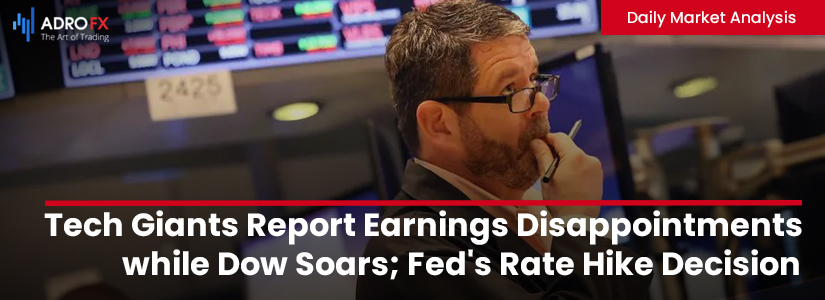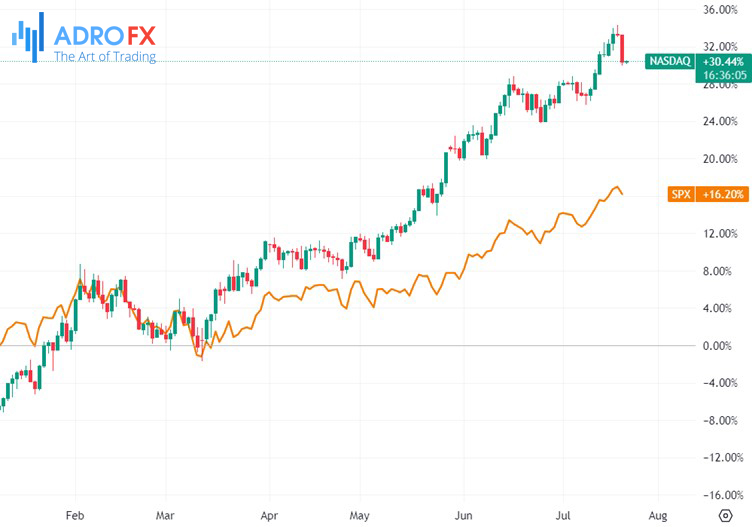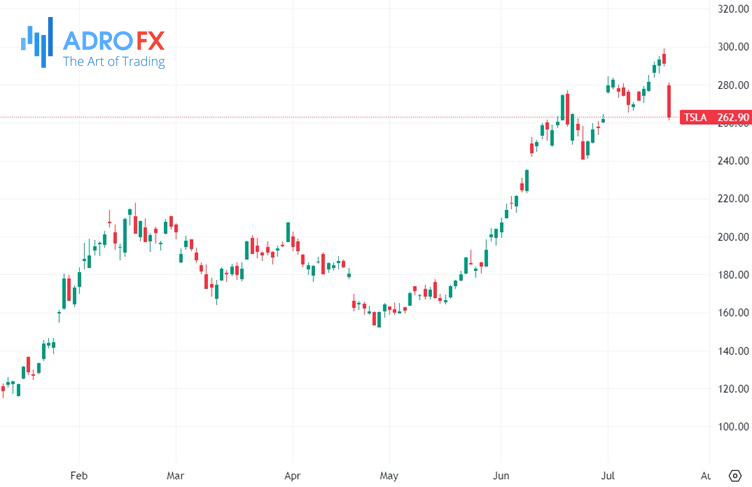Tech Giants Report Earnings Disappointments while Dow Soars; Fed's Rate Hike Decision and Economic Reports Await | Daily Market Analysis

Key events:
- UK - Retail Sales (MoM) (Jun)
- Canada - Retail Sales (MoM) (May)
On Thursday, both the S&P 500 and Nasdaq experienced declines due to the disappointing quarterly results of Tesla (NASDAQ: TSLA) and Netflix (NASDAQ: NFLX). However, the Dow managed to continue its positive streak for the ninth consecutive day, thanks to Johnson & Johnson (NYSE: JNJ) posting a strong annual forecast, which boosted its share prices.

Tesla's shares plummeted by 9.20%, marking their most significant daily percentage drop since April 20. This decline was prompted by the electric-vehicle manufacturer reporting a drop in its second-quarter gross margins to a four-year low. Furthermore, CEO Elon Musk hinted at the possibility of more price cuts, which further contributed to the negative sentiment surrounding the stock.

Meanwhile, Netflix's stock slumped by 8.24%, marking its most substantial daily percentage fall since December 2022. The decline was a result of the streaming video company's quarterly revenue falling short of estimates, leading investors to react negatively to the news.
At the same time, the dollar index remains strong and is once again approaching the psychological barrier of 100, despite a previous attempt on Wednesday that failed to close above this level.

Following a 2.9% drop over the past two weeks, triggered in part by cooler-than-expected US inflation data and speculation that the Federal Reserve might conclude its tightening cycle sooner than anticipated, the dollar index began to recover momentum. This recovery gained traction on Wednesday after a period of narrow consolidation, which took the form of a triple-Doji pattern, indicating indecision in the market.
The recent price action suggests that investors are closely monitoring the economic indicators and potential changes in the Fed's monetary policy, as these factors can significantly influence the direction of the dollar index.
On Friday, gold prices experienced an increase and were on track for a positive week, largely driven by growing expectations that the Federal Reserve is nearing the end of its rate hike cycle.

This marks the third consecutive week of gains for bullion prices, and they seem to have found stability in the high $1,900s range due to the prospect of fewer US interest rate hikes for the rest of the year.
The current sentiment in the gold market is influenced by investors' perception of the future path of interest rates set by the Federal Reserve and the fluctuations in the US dollar value. These factors are crucial drivers of gold prices, and investors are closely monitoring any indications from the Federal Reserve regarding its monetary policy stance.
Over the last five trading days, the New Zealand dollar has been the weakest performer among the G10 currencies and continued to depreciate against the US dollar yesterday. The US dollar's broad rebound gained strength after the release of New Zealand inflation data, indicating that the Reserve Bank of New Zealand (RBNZ) is likely to maintain interest rates and may have already completed its tightening cycle.

In comparison, the Australian dollar has outperformed the New Zealand dollar, receiving more significant support due to global growth optimism. Although there was a brief reversal in this trend yesterday, analysts remain optimistic about the potential for the AUD/NZD pair to continue rising. Also, most maintain a long AUD/NZD trade view, as they expect a potential divergence in monetary policy, which could drive upside momentum for the Australian dollar against the New Zealand dollar.

Next week is expected to be significant, with major technology companies set to release their reports. These tech giants, like Microsoft (NASDAQ: MSFT), have experienced significant stock growth this year, driven by high hopes for artificial intelligence and its potential for explosive growth. Analysts anticipate that these companies will offer further details on their AI plans and how they will impact earnings.
The second quarter reporting season for banks will mostly conclude on Friday, with regional giants such as Comerica and Regions providing their updates. The banking sector has benefited from rising interest rates, which have allowed them to generate more revenue from loans. However, larger banks with Wall Street-focused businesses had to navigate a decline in deal-making activities, which affected their overall revenue.
The upcoming week also holds significance for those keeping an eye on the Federal Reserve's decisions. The central bank is scheduled to meet to determine interest rates once again. The general expectation is that the Fed will raise rates by another quarter of a percentage point. Many will be paying close attention to Chair Jerome Powell's press conference on Wednesday afternoon for additional hints about the Fed's future course.
Following the interest rate decision, two key economic reports are due for release. These include the second-quarter gross domestic product (GDP) reading and the latest update on the personal consumption expenditures index, a critical measure of inflation. Both reports are set to be released later in the week and will be closely scrutinized by investors and policymakers alike.









